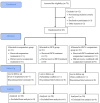Effects of transcranial direct current stimulation combined with acupuncture therapy on brain network functional connectivity in patients with knee osteoarthritis: a single-center randomized controlled trial
- PMID: 40660313
- PMCID: PMC12257676
- DOI: 10.1186/s12984-025-01692-y
Effects of transcranial direct current stimulation combined with acupuncture therapy on brain network functional connectivity in patients with knee osteoarthritis: a single-center randomized controlled trial
Abstract
Background: In this study, we investigated the effects of transcranial direct current stimulation (tDCS) combined with acupuncture therapy on pain, dysfunction and functional connectivity in patients with knee osteoarthritis (KOA), and to evaluate its potential therapeutic value.
Method: In this single-center, randomized controlled trial, patients were recruited from May 2023 to August 2024 from the Departments of Rehabilitation, Orthopedics, and Pain Management at the Affiliated Hospital of North Sichuan Medical College. The patients were randomly assigned to three groups, including the acupuncture group, the tDCS group, and the combined acupuncture and tDCS group. All treatments were administered five times a week for two weeks. The condition of the patients was evaluated by the visual analog scale (VAS), the Western Ontario and McMaster Universities Osteoarthritis Index (WOMAC), the Lequesne index, and functional near-infrared spectroscopy (fNIRS) before treatment and after two weeks of treatment, respectively.
Results: In total, 63 patients were enrolled and randomly assigned to three groups. Three patients were excluded for work-related reasons, fear of acupuncture, or time conflicts repectively, which prevented further follow-up. The VAS score, WOMAC score, and Lequesne indexes of all patients were significantly lower after treatment than before treatment (P < 0.01). Compared to the tDCS group and the acupuncture group, the combined group showed greater improvements in the VAS score, WOMAC score, and Lequesne indexes (P < 0.05). The fNIRS results indicated a significant reduction in the mean cerebral functional connectivity strength based on oxyhemoglobin (HbO2) and deoxyhemoglobin (HbR) across all three groups following treatment (P < 0.05). The functional connectivity strengths of the HbO2-based LPFC ~ LPFC, RPFC ~ RPFC, LMC ~ LMC, RMC ~ RMC, LPFC ~ RPFC, LPFC ~ LMC, LPFC ~ RMC, RPFC ~ LMC, RPFC ~ RMC, LMC ~ RMC; HbR-based LPFC ~ LPFC, RPFC ~ RPFC, LMC ~ LMC, RMC ~ RMC, LPFC ~ LMC, LPFC ~ RMC and LMC ~ RMC in the combined group were significantly lower than those in the acupuncture group (P < 0.05).The HbO2-based LPFC ~ LPFC, RPFC ~ RPFC, LMC ~ LMC, and RMC ~ RMC in the combined group were significantly lower than those in the tDCS group (P < 0.01). Compared to those in the acupuncture group, the HbR-based LPFC ~ LPFC and LMC ~ LMC of the patients in the tDCS group were lower (P < 0.05).
Conclusions: The combination therapy of tDCS and acupuncture is better than monotherapy in relieving pain and dysfunction in patients with KOA. The improvement in efficacy may be related to the reduction in brain functional connectivity and may become a new treatment method for treating KOA.
Trial registration: ChiCTR2300073819.
Keywords: Acupuncture therapy; Functional near-infrared spectroscopy (fNIRS); Knee osteoarthritis (KOA); Transcranial direct current stimulation (tDCS).
© 2025. The Author(s).
Conflict of interest statement
Declarations. Ethics approval: This study involves human participants and was carried out in accordance with the World Medical Association Declaration of Helsinki on Ethical Principles for Medical Research Involving Human Subjects. The protocol was approved by the Ethics Committee of our hospital (2023ER145-1). Participants gave informed consent to participate in the study before taking part. Disclaimer: The funder was not involved in the study design, data analysis or interpretation. Patient and public involvement: Patients and/or the public were not involved in the design, conduct, reporting, or dissemination plans. Patient consent for publication: Consent obtained from Patient/family member. Provenance and peer review: Not commissioned; externally Peer Reviewed. Competing interests: The authors declare no competing interests.
Figures




References
-
- Wang Bo YN. Consensus of four-stepladder program of knee osteoarthritis (2018). Chin J Joint Surgery(Electronic Edition). 2019;13(01):124–30.
-
- DONG Yawei LSJY, Ruihan LI, Weiheng CHEN. TCM interpretation of Chinese guideline for diagnosis and treatment of Osteoarthritis(2021 Edition). World Chin Med. 2023;18(16):2377–81.
Publication types
MeSH terms
Grants and funding
LinkOut - more resources
Full Text Sources
Medical

